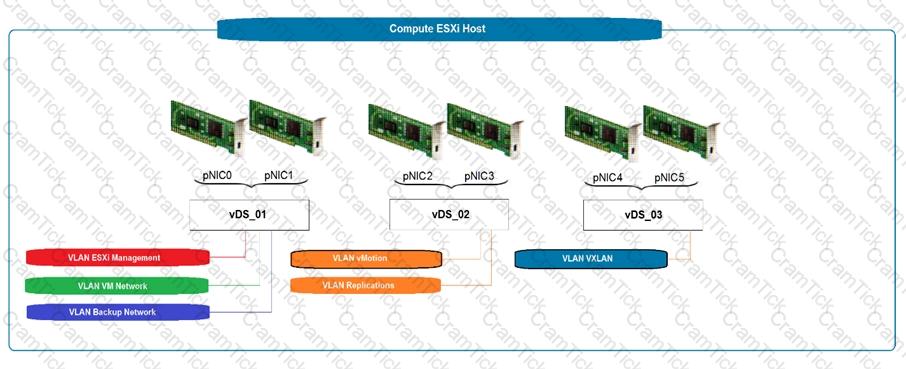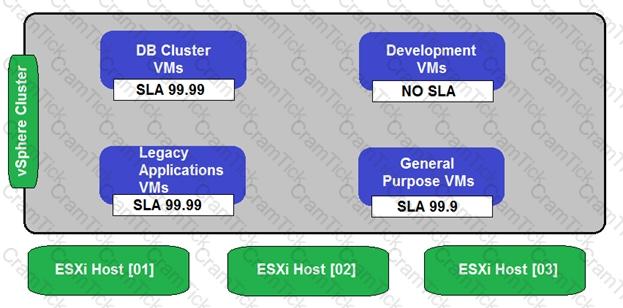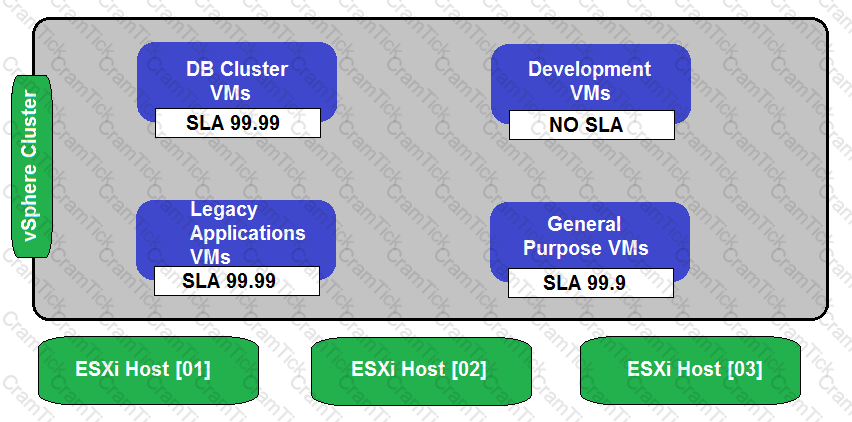In a meeting to discuss the minimum viable product (MVP) deployment of a new customer-facing application, the key stakeholder shares details of the application components and the application administrators share details of performance and integrity tests for the application.
The application will be made up of the following components:
-Steps to confirm the web server is operating correctly will take 15 minutes after the application server is online.
-Steps to confirm application server integrity will take 15 minutes after the database is online.
-The database server will be managed by a database administrator, with an agreed service-level agreement (SLA) to restore and validate database services within one hour.
The existing VMware infrastructure offers a recovery point objective (RPO) of 5 minutes and recovery time objective (RTO) of 15 minutes through a combination of backups and replication.
In the event of an outage impacting all three application components, how long will it take for the application to recover and complete all checks?
An architect is designing a VMware solution for a customer based on the following information:
Which two design decisions could the architect make to meet these requirements? (Choose two.)
Refer to the exhibit.
During a requirements gathering workshop, the architect shares the following diagram:

What should the architect recommend for guaranteed throughput for each service?
Which two of the listed requirements would be classified as manageability non-functional requirements? (Choose two.)
Which two of the listed requirements would be classified as performance non-functional requirements? (Choose two.)
An architect is designing a new vSphere environment to meet the following requirements:
Which vCenter Server appliance deployment size should the architect specify for the design?
An architect is designing a new vSphere environment with the following resources:
Average resource usage is:
The design must meet the following requirements:
What is the minimum number of hosts required to meet the design requirements?
A customer has six hosts available in a cluster. When running at full capacity, all virtual machines can be run on two hosts.
How many hosts can the customer place into maintenance mode at the same time while still providing N+2 resiliency to the cluster?
An architect has 50 ESXi hosts to deploy and DHCP servers are not allowed on any network. Which automated host deployment method should the architect use?
A customer is deploying a new cluster and wants to be able to patch and update two hosts in parallel. The cluster must be able to maintain N+1 resiliency across the remaining hosts while patching activities are performed. The current expected utilization of the platform requires a minimum of two hosts to support all of the virtual machines.
What is the minimum number of hosts the customer will require in the cluster in order to meet the required resiliency level?
An architect is designing a VMware solution for a customer to meet the following requirements:
Which design decision should the architect make to meet these requirements?
Refer to the exhibit.
During a requirements gathering workshop, a customer shares the following diagram regarding their availability service-level agreements (SLAs):

The customer states that there is no application level availability for legacy applications.
Which recommendation could the architect make to meet the customer’s high availability requirements for the legacy applications virtual machines?
During a requirements gathering workshop, the customer’s Chief Information Security Office (CISO) provides the following requirements that are pertinent to the design of a new vSphere environment:
Which requirement classification is being gathered for the design documentation?
An organization's existing vSphere environments are configured for Enhanced Linked Mode. The DevOps team automates the creation of hardened virtual machine images for various operating systems. Their continuous integration/continuous delivery (CI/CD) pipeline runs a task at the end of a successful build, which uploads the Open Virtualization Format (OV) image to a sandbox content library, deploys a virtual machine from the image, and then destroys these objects after quality checks are complete.
The following requirements have been noted:
Which three recommendations should the architect make to design a content library solution that will meet these requirements? (Choose three.)
An architect is planning the physical server configuration for a vSAN-based infrastructure.
Which operations mode should a RAID controller support to minimize potential server downtime during physical disk failures?
During a requirements gathering workshop, the customer provides the following requirement (REQ) and constraints (CON):
Which two design decisions should the architect make to meet the customer requirement? (Choose two.)
An architect is tasked with designing a greenfield VMware software-defined data center (SDDC) solution that will be used to deliver a private cloud service for a customer.
During the initial meeting with the service owner and business sponsor, the customer has provided the following information to help inform the design:
Which two elements represent risks to the successful delivery of this solution? (Choose two.)
Which requirement would be classified as a functional requirement within the design documentation?
An architect is preparing a design for a customer. Based on requirements, the architect recommends an HCI- based infrastructure with all-flash architecture. During the assessment, it is confirmed that the network throughput generated by virtual machines does not exceed 150 Mb/s.
What is the minimum number and type of network adapters in each server that the architect can recommend to ensure requirements are met and there is no single point of failure?
Refer to the exhibit.
During a requirements gathering workshop, the customer shares the following diagram regarding their availability service-level agreements (SLAs):

The customer wants database application level availability to always take precedence. What should the architect recommend to meet the customer’s requirement?
Which design decision must be included in a design to allow for the deployment of a minimum supported configuration of vCenter High Availability (HA)?
During a requirements gathering workshop to design a physical to virtual migration, the customer provides the following information:
Which recommendation should the architect make to address the customer requirement with regard to virtual networking?
An architect is designing an environment for a retail customer. The design will use a single small vCenter Server Appliance and a cluster of eight ESXi hosts at a remote site. There is a single 10 GbE connected network at the remote site to support all management services. It is not possible to create additional management networks at the remote site. Virtual machine backups at the site will be dependent on the vCenter Server being available.
Which design decision should the architect make to maximize availability for backups?
VCAP-DCV Design 2021 | 3V0-21.21 Questions Answers | 3V0-21.21 Test Prep | Advanced Design VMware vSphere 7.x Questions PDF | 3V0-21.21 Online Exam | 3V0-21.21 Practice Test | 3V0-21.21 PDF | 3V0-21.21 Test Questions | 3V0-21.21 Study Material | 3V0-21.21 Exam Preparation | 3V0-21.21 Valid Dumps | 3V0-21.21 Real Questions | VCAP-DCV Design 2021 3V0-21.21 Exam Questions


